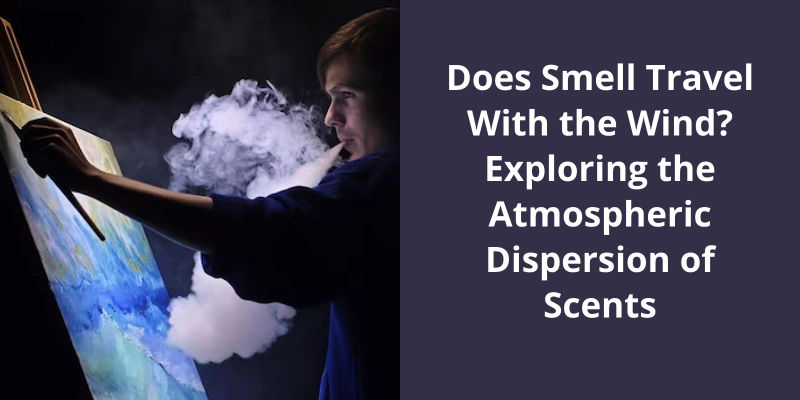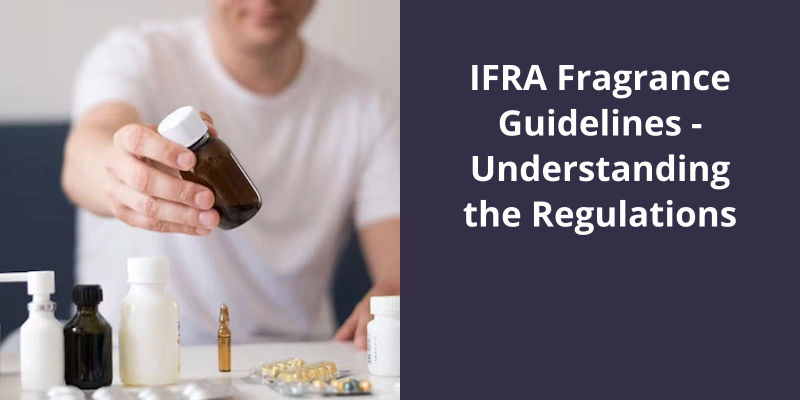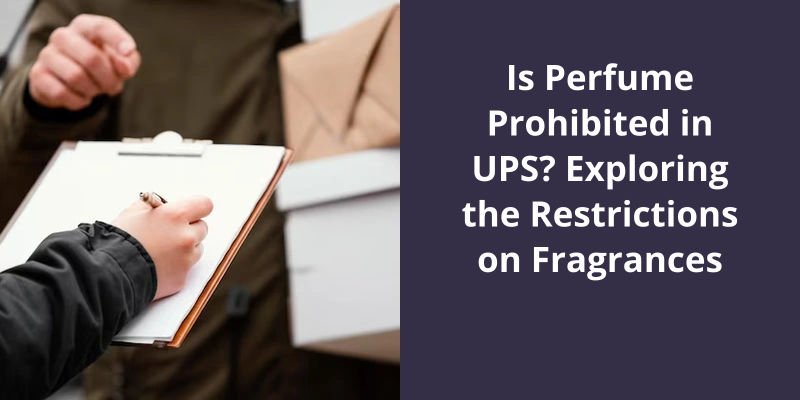Yes, smell does travel with the wind. This occurs as the wind carries tiny particles, known as scent molecules, from the source of the smell. These molecules enter our noses when we breathe, which we interpret as different scents. The direction and speed of the wind can greatly influence how far and fast these scent molecules travel. Therefore, if the wind is blowing from the direction of the smell source towards you, you are more likely to catch a whiff. Conversely, if the wind is blowing the other way, you might not smell anything at all.

How Does Smell Stay in the Air?
When a smell is released into the air, it’s made up of tiny particles that are lighter than air molecules. These particles are commonly referred to as volatile organic compounds (VOCs). The high volatility of these particles makes them more likely to interact with air molecules, which results in their diffusion into the atmosphere. The released particles travel through the air by mixing with the ambient air, eventually spreading outwards in all directions.
Various factors can impact the diffusion of odor particles in the air, the most significant of which is temperature. Higher temperatures result in more significant dispersal of odor molecules, which is why you tend to smell things more strongly during the hot summer months. Humidity levels and air currents also play a role in the way smells travel, especially at ground level. Warmer, humid air tends to hold scents close to the surface, while breezy weather can disperse them more freely.
The size of the odor molecule and the air pressure surrounding it can also impact the way smells travel. Smaller molecules tend to move more easily through the air, but larger ones can still move with the help of air pressure changes, such as when air is compressed or rarefied due to atmospheric instability or weather patterns. Odor particles can remain suspended in the air for hours or days, depending on the volatility of the particles and air currents present in the environment.
One reason why some smells may linger in the air for an extended period has to do with it’s chemical composition. Some chemicals that make up the odor have properties, molecular shapes, and bond types that make them bond to surfaces, such as clothing or curtains, rather than disperse into the atmosphere. These molecules will remain attached to that surface until the bond breaks down or is washed away.
How Do Air Filters and Purifiers Affect the Way Smells Stay in the Air?
- Air filters and purifiers can capture and remove odor molecules from the air, reducing the intensity of smells in the room.
- Certain types of air filters, such as activated carbon filters, are specifically designed to target and absorb odors.
- While air filters and purifiers can help improve the overall air quality in a space, they may not completely eliminate all odors.
- It’s important to regularly replace air filters and clean air purifiers to maintain their effectiveness in removing odors.
- Other factors, such as humidity and ventilation, can also play a role in how smells linger in the air.
This difference in speed can have varying effects on how we perceive smells, and it also plays a role in how odor molecules interact with their environment. Understanding the mechanics of this process is important in fields such as fragrance production and environmental science. Let’s explore some of the factors that influence the speed at which smells travel.
Do Smells Travel at the Same Speed?
The speed at which a smell travels depends on a number of factors such as the type of odor, the temperature of the air, and the humidity. For example, the speed at which a floral scent like lavender travels through the air is different from the speed at which a musty odor like wet soil travels.
Warmer temperatures typically cause molecules to move more quickly and bounce around more, which means that odors can travel faster. Conversely, colder temperatures slow down the movement of molecules, which can slow down the speed at which a scent travels. The humidity also affects the speed of a smell, as water molecules can sometimes attach to odor molecules and slow them down.
Understanding the speed at which smells travel can have implications for everything from agriculture to perfume-making. For example, farmers might need to know how quickly particular scents disperse through the air in order to control pests or attract pollinators. Perfume-makers might need to take into account the chemical properties of different fragrances in order to get the perfect balance of top, middle, and base notes. Ultimately, the science of scent is a fascinating and complex area of study that’s applications in many different fields and industries.
Source: How fast do smells travel?
While hunters may prefer calm winds, the movement of scent with wind has implications beyond just hunting. In fact, understanding how scent travels with wind is important in a variety of industries, from agriculture to environmental monitoring. So, let’s take a closer look at how wind affects the movement of smell.
Does Smell Move With Wind?
This is because they believe that scent can travel further and more accurately in calm conditions. However, scientists have found that scent molecules can also be carried by turbulent air, which can result in a more erratic and less predictable scent dispersion pattern.
Fragrances can also become trapped in natural barriers such as hills, mountains, and valleys leading to localised concentration and subsequent dilution. So, while wind is certainly a key factor in the movement of scent, it isn’t the only factor.
Warmer air is generally less dense than cooler air, and this can cause scent molecules to rise and diffuse more rapidly.
Likewise, high humidity can help to carry scent further as moisture helps to bind scent molecules, making them more likely to stay together and travel.
While calm conditions may be more favourable for hunters seeking to track certain game, it’s important to remember that scent can still move in unpredictable ways even under the calmest conditions.
But have you ever wondered if odor can travel through water? It turns out that the answer is yes. While scent molecules move differently through water than they do through air, they can still be detected by organisms living in aquatic environments. In fact, some predators even use their sense of smell to track down prey in the water. Let’s explore this topic further.
Does Odor Travel Through Water?
Odor and scent are relatively complex phenomena. They’re caused by molecules being released from a source and traveling through the air or water before finally reaching our noses. Whether or not odors travel through water is a common question, and the answer is yes, they do. The way that odors travel through water is slightly different from the way they travel through air, but the basic principles are the same.
This means that it takes more energy for a molecule to move through water than it does through air. However, once an odor molecule has made it through the water, it can still be detected by our noses.
As water heats up, it’s molecules become more active, which can help to speed up the movement of odor molecules through the water. Conversely, if the water is cold, the movement of odor molecules will likely be slower.
Interestingly, some species of fish have evolved the ability to detect odors in the water as a means of finding food or mates.
Can Some Odors Be Detected More Easily in Water Than in Air?
The sense of smell can vary depending on the medium in which odors are present. Some odors may be easier to detect in water than in air.
Now that we know that all smells eventually dissipate, it’s important to understand the factors that affect how long it takes for an odor to fade away. From the type of smell to the environment it’s in, various elements can impact the lifespan of an aroma. Let’s dive deeper into the science of scent and explore the nuances of how smells disappear over time.
Will a Smell Eventually Go Away?
However, the length of time it takes for a smell to fade away depends on various factors such as the type of odor, it’s source, the intensity of the smell, the environment, and the ventilation. Certain odors such as those from cigarettes, pets, and cooking may also get trapped in fabrics, carpets, or walls, making them more challenging to eliminate.
Similarly, the effectiveness of odor removal strategies such as airing out the space, using deodorizers, or washing fabrics may vary depending on the nature of the smell. While opening windows and doors and using fans may help to increase the circulation of air and remove some of the odor molecules, it may not be enough to get rid of strong or stubborn smells. In such cases, you may need to use specialized products like ozone or activated charcoal that can absorb or neutralize the odor molecules.
Moreover, the duration of a smell may also depend on the sensitivity of the individuals sense of smell. Some people may be more sensitive to certain odors than others, making it difficult for them to tolerate even mild smells. In contrast, some people may not detect certain smells at all, even if they’re present in high concentrations.
In certain cases, a persistent smell may also be a sign of an underlying issue like mold, mildew, or bacterial growth. In such scenarios, it’s crucial to identify and address the root cause of the odor to prevent it from recurring. This may require professional intervention, such as mold remediation or HVAC cleaning, to eradicate the odor and ensure that the air quality is safe.
However, identifying the cause of the odor and implementing appropriate solutions can help to expedite the process and ensure that your living or working environment is comfortable and odor-free.
How to Prevent Smells From Occurring in the First Place
Preventing smells from occurring in the first place can be achieved through simple routines and habits such as regular cleaning, proper ventilation, and identifying and eliminating potential sources of odor. This also includes proper storage and disposal of food waste and cleaning up spills immediately. Additionally, using air fresheners or natural remedies such as baking soda or essential oils can help to keep spaces smelling fresh.
Conclusion
In conclusion, the movement of odor and it’s dispersion in the atmosphere is highly dependent on the direction and speed of wind. This understanding can be crucial in identifying and mitigating potential risks associated with odor release from various sources. By analyzing the wind direction and it’s interactions with different features of the environment, it’s possible to determine the areas that are most likely to be affected by the odor and take necessary action to prevent exposure. Overall, the study of odor dispersion in the atmosphere has significant practical applications for both industrial and environmental purposes.





